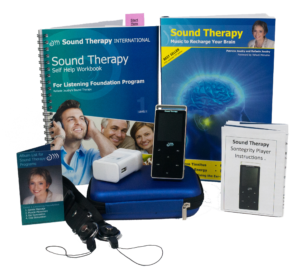Research on sounds that stimulate the brain
Jim Millburn embarked on a course of Sound Therapy after reading how it could bring about a number of improvements to brain function generally. He said that after four weeks of listening he experienced the classic symptoms of Opening of the Ear, as described in the Sound Therapy literature.
“It was heralded by a strange feeling which overcame me both mentally and physically,” he said. “My mind suddenly swept aside all thoughts and became totally clear and focused in a manner that I had never experience previously. This was accompanied by a surge of energy which built up and charged my whole body, providing sources of energy which became evident in my swimming and tennis.”
Over the next few weeks as he continued to listed, Jim was delighted and surprised to find that his sense of taste, which had been very poor, say 2 out of 10, improved to 5 out of 10 so he was enjoying his meals far more than before. “My poor concentration also showed considerable improvement,” he claims, “to the extent that it was quite evident that something remarkable had taken place.”
Music can soothe the savage beast, it can bring back memories, lift the mood and create a particular atmosphere. But can it be so powerful as to restore the brain to high levels of functioning? If so, how does it actually work to affect us so deeply?
Discoveries in the new field of neuropsychology, along with recent research on brain plasticity, are scientifically proving what we have always known.
Researchers proved that if someone loses a finger, for example, the area of the brain used for controlling that finger will be taken over by the neighbouring finger. People who lose their vision may apply some of the visual cortex to processing other senses. Just as products compete for space on a supermarket shelf, processes compete for space in the brain. In other words, “use it or lose it.”
Much research has confirmed that activities like crosswords, studying new information, learning a musical instrument and physical exercise, stimulate the brain and help keep its functions alive. Learning new activities or being stimulated in new ways also enhances brain function by driving the brain to form new connections.
The current surge of popular interest in brain plasticity has many people asking, “How can I best stimulate my own brain to enhance my longevity and healthy functioning?” Sudoku and the Rubiks Cube are enjoying a resurgence as everyone wants to preserve their memory, attention, creativity, and keep those neurons firing. Another, easy way to maintain top brain function is with music, but what sort of music?
Research in several fields has been brought together in a new discipline known as “sound therapy” to leverage the potential of sound stimulation for the brain.
Dr Georgi Lozanov, a Bulgarian doctor and psychiatrist, concluded back in the 1950s that we are using only a fraction of our brain potential. He is considered the father of accelerated learning for his discovery of how slow baroque music can make the brain more receptive to learning.
Dr Georgi Lozanov, a Bulgarian doctor and psychiatrist, concluded back in the 1950s that we are using only a fraction of our brain potential. He is considered the father of accelerated learning for his discovery of how slow baroque music can make the brain more receptive to learning.
Dr Tomatis, an ENT in Paris pursued the avenue of filtered high frequency sounds to improve ear function. He then found that while activating the ears with high frequencies, he was stimulating brain pathways, releasing latent energy in the brain and improving learning, language, memory and many other brain functions. Recent discoveries by Dr Richard Davidson, examined at seminars involving the Dalai Lama, explain why Tomatis’s Sound Therapy also improves optimism and happiness by stimulating certain centers in the left pre-frontal cortex.
Myths dispelled
Up until about 20 years ago, scientists believed that the brain could not change. The belief was that we were born with a certain number of neurons and when those began to die off in our 20s there was no going back. There was also a strong school of belief about localisation, which held that each of our functions was hardwired to a particular part of the brain. For example there was an area for the hand, an area for the foot, an area for visual imagination and one for musical memory.
While there is a grain of truth to each of these theories, we now know that in fact the brain is much more complex and mutable than we thought. The new technology of MRI (Magnetic Resonance Imaging) and PET (Positon Emission Tomography) allows us to see which parts of the brain are lighting up during particular activities.
The book I co-authored with my mother, Patricia Joudry describes how Sound Therapy has become readily available for use by practitioners and the public. It delves into the theories of Dr Tomatis and discusses the application of Sound Therapy to many different health and educational practices. The book is called Sound Therapy: Music to Recharge Your Brain by Patricia Joudry and Rafaele Joudry. It is available for purchase or, for a limited time, as a free ebook, from http://soundtherapy.com.au/how-it-helps/brain-performance/creativity/
Phone us on 1300 55 77 96 Ask for additional information for practitioners.


